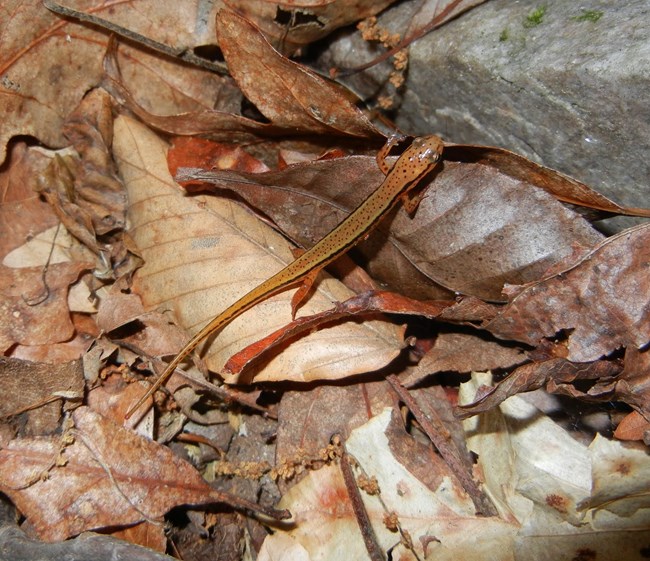
NPS Photo Family: Plethodontidae Eurycea cirrigera Southern Two-lined Salamander
Size: 6.4 to 12.1 cm long (2 ½" to 4 ¾") General Description: Skin yellowish to yellow-brown, green, orange or bronze-ish. Narrow dark brown or black dorsolateral stripe running from each eye to almost tail tip. Males have downward projections from nostrils. Skin often has dark speckles. Belly yellowish in color and relatively unmarked. Keeled, compressed tail, slightly oval in cross section. 13 to 16 costal grooves, most commonly 14 though. Tail typically makes up 55-60% of total length. Hatchlings and larvae are aquatic and have stream-type morphology. Hatchlings and larvae are typically dusky colored with 6 to 9 pairs of dorsolateral spots on the back and a light colored belly. Similar Species: E. aquatica has almost identical coloration and patterning but is slightly smaller Habitat: Streams, stream margins, and riparian areas.
Similar Species: Dwarf Two-lined Salamanders, Eurycea aquatica, has a relatively shorter tail that is only about half of total length. Northern Two-lined Salamanders, Eurycea bislineata, tend to have 15-16 costal grooves and a different range than this Southern species. Some sources may consider this species to be a subspecies of E. bislineata. Three-lined Salamanders, Eurycea guttolineata, are typically a bit larger, have a more mottled belly and have a mid-dorsal black or dark brown stripe, sometimes broken into blotches, running from behind the eyes to part way down the tail. Reproduction: Suspected to breed from late fall to early spring. Habitat: Prefers the edges or rocks along or in brooks, streams, springs, river swamps, seepages, and floodplain bottoms. Also damp forest floors at higher elevations. Found from near sea level up to 6,000' (1,829 m) in elevation. Behavior: Females typically lay eggs in running water on the underside of rocks or debris. Males may be aggressive towards other males of species during breeding season. Larvae have conspicuous yolk reserves upon hatching and may not start feeding until yolk reserves are gone. Larvae forage along stream bottoms during any part of the day or night and transform after 1 or 2 years. May leave stream edges to forage on the forest floor during warmer months. Typically spends colder months underground. Adults may show territorial behaviors, defending home areas by biting or posturing aggressively when confronted by intruders.
|
Last updated: April 14, 2015
